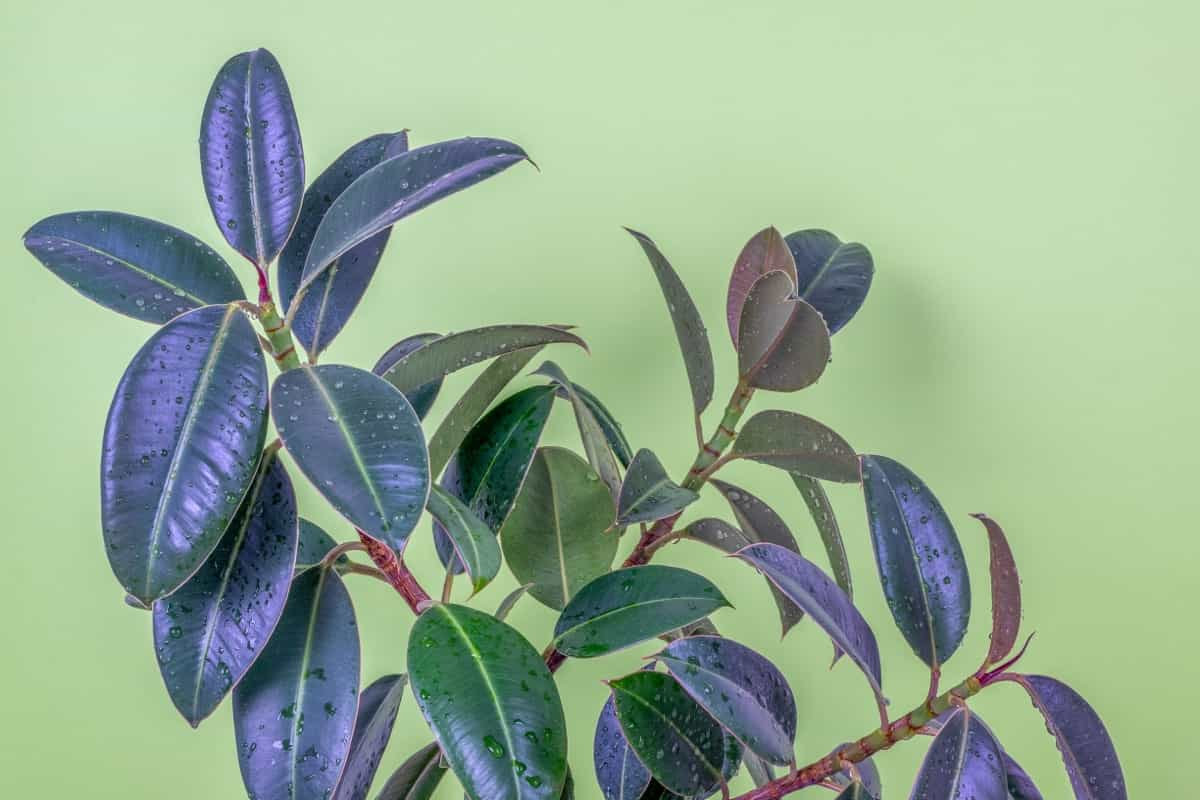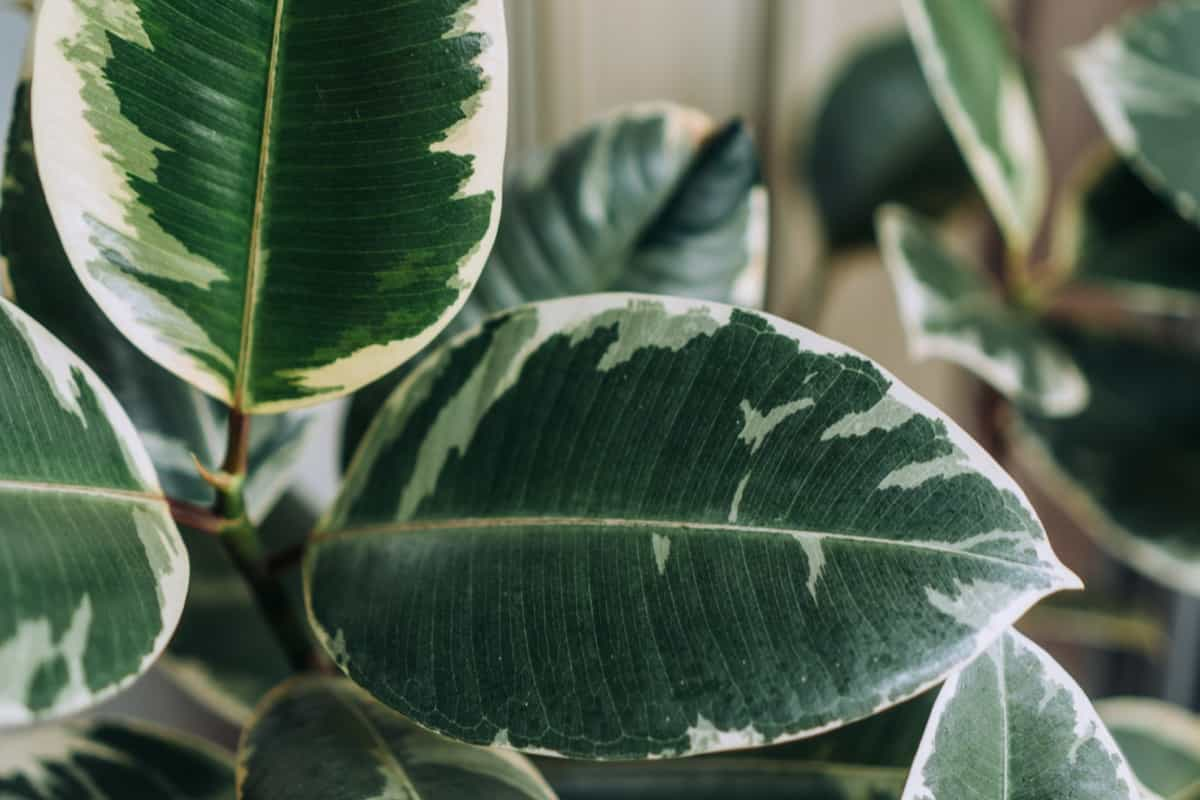Rubber plants, also known as Ficus elastica or Rubber tree plants, are popular for houseplants because of their unique appearance and ease of care. A bushier Rubber plant can provide more shade to other plants, creating an optimal growing environment for all your greenery. It also creates a visually appealing natural divider between different areas of your living space.

How to Make Rubber Plants Bushy
Prune Rubber Plant to Encourage Bushier Growth
- You can cut off unwanted branches of the Rubber plant and discard them. This technique may seem counterintuitive since cutting away parts of a plant often seems like it would hinder its growth. But when done correctly, it provides ample space for new branches to sprout up from where they were pruned.
- Propagating in water or soil is another effective method for encouraging a fuller-looking Rubber plant. You can snip off healthy leaves with at least one node and place them in water or soil until roots form; then, transfer them into pots.
- Air layering involves making an incision on the stem below a node and wrapping damp sphagnum moss around it before covering it with plastic wrap or foil paper wrapped around it tightly until roots form. Once established, cut below the root system and pot separately.
- Keeping your Rubber plant trimmed regularly can prevent overcrowding and ensure proper airflow between leaves – this helps reduce pests or diseases.
How To Make Rubber Plants Grow Faster?
- Increase Light Exposure: Rubber plants thrive in bright indirect light, so increasing their exposure will help them grow faster.
- Use Fertilizer: A good fertilizer with balanced nutrients will help encourage speedy growth in your Rubber tree.
- Water Regularly: Consistent watering helps keep soil moisture levels consistent, which promotes faster growth.
- Provide Adequate Space: Make sure your pot size is large enough for the roots of a rapidly growing Rubber tree, as they need space to spread out and take hold in new soil.
Growing Tips to Make a Rubber Plant Bushy
- Pruning your Rubber tree plant regularly helps to encourage new growth and prevent leggy stems.
- Repotting your Rubber plant every year or two also promotes bushiness since it provides fresh soil for the roots to grow in and more space for the plant’s expanding root system.
- Proper care is essential in growing a healthy and bushy Rubber plant. Ensure it receives bright indirect sunlight – too much direct sun can burn its leaves, while too little light causes stunted growth. Watering must be done when the top inch of soil feels dry; overwatering leads to root rot, while underwatering results in browned leaves and wilting.
- Consider staking your Rubber Tree Plant with bamboo sticks or rods after pruning; this encourages upright growth and prevents floppy branches from breaking off due to weight.
In case you missed it: How to Make Chrysanthemums Bushy: Best Homemade Fertilizers, Composting, and Pruning Tips

Homemade Fertilizers for a Bushy Rubber Plant
- The first homemade fertilizer option for your bushy Rubber plant is eggshells. This natural source of calcium can easily be turned into a nutrient-rich powder by blending it into a food processor or coffee grinder. Sprinkle this powder over the soil around your Rubber plant’s base once every two months.
- Another great homemade fertilizer idea is banana peels. These contain high levels of potassium, which will encourage thicker foliage growth from your Rubber tree. You can chop fresh banana peels and bury them in the soil around your plant.
- Another popular natural fertilizer option for Rubber plants is Epsom salt mixed with water. Mix about 1 tablespoon per gallon of water and use this mixture to water your Rubber plants every three weeks.
Composting to Make Rubber Plant Bushy
- Composting is an excellent way to promote bushy growth in your Rubber plant. Composting involves breaking down organic material into a soil amendment used to fertilize Rubber plants. Compost adds essential nutrients to the soil, improves its structure, and helps retain moisture.
- To start composting for your Rubber plant, you will need a bin or container to collect kitchen waste, coffee grounds, eggshells, tea bags, and fallen leaves and grass clippings. You may also add wood ash or sawdust but avoid adding animal products like meat or dairy.
- Once your compost has broken down sufficiently (typically 3-6 months), mix it into the soil around the base of your Rubber plant. This will provide slow-release nutrients over time, helping encourage healthy root systems resulting in more leafy growth.
- Composting provides numerous benefits for Rubber plants and other houseplants or outdoor garden beds, promoting the overall healthy growth of plants while minimizing environmental waste.
What Is a Natural Fertilizer for Rubber Trees?
- Rubber plants prefer slightly acidic soil; coffee grounds can provide that acidity while slowly releasing nutrients to the roots. However, it’s important not to use coffee grounds directly on the plant as they can burn the leaves or stem. Instead, mix them into compost before using them as fertilizer for your Rubber tree.
- Making compost with coffee grounds is easy – add them to a bin and other organic waste like kitchen scraps and yard trimmings. These materials will break down into nutrient-rich soil that can be used to feed your Rubber tree. In addition to providing nutrients and acidity, coffee ground compost can improve drainage in heavy soils and increase water retention in sandy soils.
Pruning Tips for a Bushy Rubber Plant
- Pruning is important for maintaining plant health and bushiness. It helps to stimulate new growth from the base of the plant, making it look fuller and more attractive.
- Always use sharp scissors or shears when pruning your Rubber tree to avoid damaging the stems. Start by removing dead or yellowing leaves at the bottom of the plant. This will improve air circulation and prevent fungal diseases from spreading.
- To encourage branching, prune back long stems just above a leaf node on each stem. This will help redirect energy towards new lateral branches that grow outwards instead of upwards.
- If you want to promote even bushier growth, try pinching off new growth as soon as it appears in spring or summer. This can also help prevent leggy growth by encouraging branching at lower levels on your plant.
In case you missed it: How to Make Rose Plant Bushy: Best Homemade Fertilizers, Composting, and Pruning Tips

Conclusion
Rubber plants are popular houseplants due to their waxy leaves and impressive appearance. As indoor plants, Rubber trees thrive in bright but indirect sunlight and require well-draining soil. They prefer moderate watering with dry periods between waterings.
- Feed Your Flock for Less: Top 10 Tips to Save on Chicken Feed
- Ultimate Guide to Ossabaw Island Hog: Breeding, Raising, Diet, and Care
- Hatching Answers: The Top 10 Reasons Your Chickens Aren’t Laying Eggs
- Eggs and Economics: Breaking Down the Cost of Raising Backyard Chickens
- Defend Your Greens: Proven Methods to Keep Iguanas Out of Your Garden
- Ultimate Guide to Cinnamon Queen Chicken: A Comprehensive Guide for Beginners
- Ultimate Guide to California Tan Chicken: Breeding, Raising, Diet, Egg-Production and Care
- Ultimate Guide to Marsh Daisy Chicken: Breeding, Raising, Diet, and Care
- 10 Types of Chicken Farming Businesses You Can Start for Profits